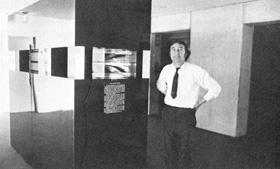New Cosmic Ray Detector Exhibit

M. Atac with new spark chamber exhibit on the Central Laboratory's 15th floor
Cosmic rays.
The words bring to mind visions of outer space, spaceships and Flash Gordon-type action adventures. Actually, cosmic rays are mysterious sub-microscopic particles. Their origins in space are unknown, but the average person is exposed to about 500,000 cosmic ray particles daily.
A new Fermilab exhibit enables employees and the public to see cosmic rays arriving. The display is called a spark chamber. Installed on the 15th floor north observation area, the display gets its name from sparks that are seen when cosmic rays are detected. It resembles a six-foot-tall black plastic box, with windows on two sides. The chamber's inner workings are illuminated when a visitor pushes an "X" button.
Muzaffer Atac, detector development group head in Research Services, created the display. He said its purpose is to give non-scientists a better understanding of Fermilab's research. He noted that spark chambers are "detectors" that physicists use to record results and learn about processes taking place deep inside the atom's nucleus. In addition, other uses range from x-ray and gamma-ray astronomy, to nuclear medicine and biology, to radioactive studies and even archaeology.
Other types of detectors used at Fermilab include drift chambers, proportional wire chambers and bubble chambers. Momentum resolution, data rate expected and estimated cost determine which type of detector will be built for an individual experiment, he said.
The new display was constructed with materials borrowed from Argonne National Laboratory, courtesy of Tom Romanowski, former high energy physics department head. Several months' part time work by Atac, technicians J. Urish, M. Hrycyk, W. Coleman, artist Angela Gonzales and the model shop went into the project.
Aluminum foils 0.005-inch thick are stretched and positioned on plastic frames. The thin aluminum foils serve as electrodes for each of 20 spark chamber gaps. The active area of each chamber is 20 x 40 inches. An atmosphere of 90% neon and 10% helium fills the gaps.
Long plastic scintillators, light detectors, are placed above and below the frames. When a ray or rays passes through the scintillators, a circuit produces an electronic signal. This triggers a high voltage pulser and 6,000 volts is applied to the chambers.
The electric field accelerates electrons created during the cosmic rays' passage through the chamber. Electrons then colliding with neon-helium atoms produce a ZAP and an orange spark resembling a mini-lightning bolt. The whole process lasts less than one millionth of a second!
The new display joins an optical/electronic spark chamber on view in the atrium lobby since June, 1975.
Brief non-technical texts attached on both exhibits explain cosmic rays, detectors used in physics and operating information.


